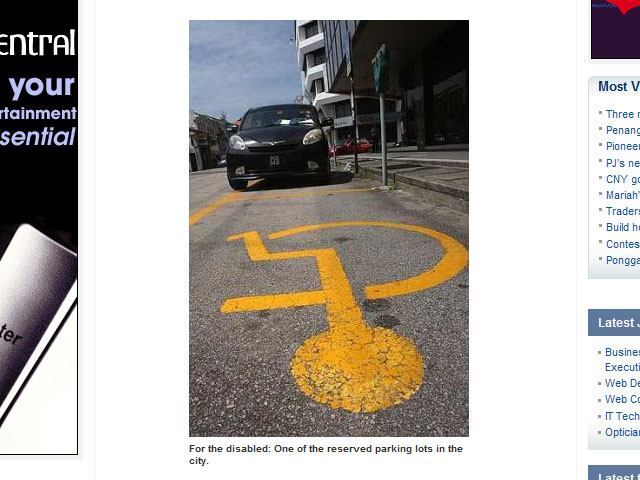Selangor issued free parking stickers to disabled persons some time in September last year which covered all the municipalities in the state. Penang just issued similar free parking stickers to disabled persons for areas under the jurisdiction of the Majlis Perbandaran Pulau Pinang (MPPP).
Frankly, I would not mind paying for parking if there are sufficient accessible parking spaces and the parking meters are convenient to use. After all, what is 30sen per half hour compared to parking in shopping complexes which ranges from RM1 to RM3 per hour?
Nevertheless, in my opinion, the practice of providing free parking for disabled people should be tied to the provision of accessible public transport and built environment. Many disabled people are compelled to drive because that is the only way to travel. The infrastructure in Malaysia is still as inaccessible as it was half a century ago.
If public transport and the built environment can provide a seamless journey, I would very much prefer to use public transport instead of going through the hassle of transferring from wheelchair into the car and vice versa, and then have difficulty looking for a suitable parking space. Using public transport is cheaper too as compared to paying for car installments, petrol and maintenance.
Free parking, therefore, should be viewed as a form of “compensation” for the lack of accessible infrastructure that impedes the mobility of disabled people. It should never be considered an act of charity on the part of the government and a right to such freebies on the part of disabled people.
Charity is not a right. It puts the beneficiary on an unequal footing with the benefactor. In the pursuit of rights, equality and dignity, disabled people should not expect to be accorded privileges. If we want equality, then we have to play our part in society, too, by paying for our share.
Anyway, what I would like to see is sufficient parking spaces of the correct dimensions for wheelchair users to exit and enter the car conveniently and safely, and that these spaces are not abused by non-disabled drivers or vehicles without a disabled passenger.
Accessible parkings should preferably be perpendicular to the kerb. The recommended width is 3.6m as prescribed in the Guidelines on Buildings Requirements for Disabled Persons published the Jabatan Kerajaan Tempatan. This recommendation complies with MS 1184 and MS 1331. The recommended width for a regular parking space is 2.4m.

Parking for disabled people in Penang – screen capture from The Star Online.
Parallel parking is not recommended unless it is away from the flow of traffic. It poses a safety risk for the wheelchair user when exiting or entering the car with the traffic passing by at close promixity. This point is what I wanted to raise when I saw the image in The Star Online.
The parking space is barely wide enough to fit the Myvi. There are two scenarios here. One: The disabled driver risks getting hit by passing traffic while entering or exiting the car, there being no space allowance for wheelchair from the flow of traffic. Two: A disabled passenger will not be able to get out. There is no space between the car and kerb on the front passenger side.
Simply painting a wheelchair logo on the parking space does not make it instantly useful for disabled people. It is apparent here that there is no compliance whatsoever to the code of practice. MPPP should upgrade these parking spaces to the proper dimensions to ensure safety and functionality of users.
I applied for and got the parking sticker from Majlis Perbandaran Ampang Jaya (MPAJ) in December last year. Having this sticker does not make it any more convenient when going out. Accessible parking spaces are far and few in between. When I did come across any, it would mostly probably occupied by vehicles without these stickers or other stickers with the wheelchair logo.
Selangor and Penang have taken the lead in this matter. Both states now need to ensure that there are sufficient accessible parking spaces and impose strict enforcement against people who abuse these facilities. While they are at it, they should also ensure that the areas surrounding these parking spaces are barrier-free. There is really no point in being able to park for free and not being able to move around in a wheelchair in those places.
Nonetheless, I commend the governments of Selangor (my adopted state) and Penang (my home state) for moving forward in issues of accessibility. I hope they will not rest on their laurels. There is a lot more that needs be done to ensure the full inclusion of disabled people in society.


